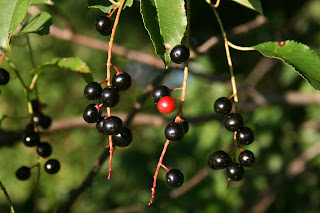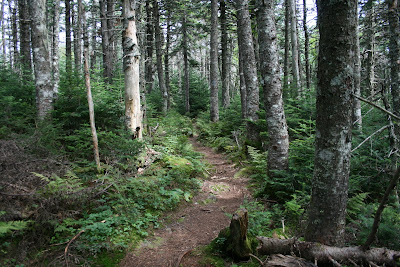Kodi's strong, young legs and great spirit has refreshed our interest in hiking, especially in the White Mountains. The weather forecast for Friday and Saturday called for clear skies and pleasant temperatures in the mountains, so we gathered up our hiking and camping gear and headed north to the Kancamagus Highway.
We parked at a scenic overlook on the Kanc, which offered a beautiful view of Mt. Osceola. The morning was crisp and clear, perfect for hiking up to the Hancocks.
View of Mt. Osceola from Overlook on Kancamagus Highway
The Hancock Notch Trail follows an old railroad bed and logging road. We set off at a brisk pace as the morning air was cool and the flat, wide trail made for easy walking. The Kancamagus Highway has the highest elevation of any paved road in the northeast, as such we were already at 2,100 feet when we started our hike. The surrounding forest was mostly spruce and fir, with some paper birch and red maple.
At 1.8 miles we turned left onto the Cedar Brook Trail. This trail follows alongside the North Fork of the Hancock Branch of the Pemigewasset River, one of the great rivers in New Hampshire. The Cedar Brook Trail crosses the North Fork five times. The water ran clear and cold and was low enough that we could rock hop across without getting wet feet. Kodi stopped at each crossing for a deep drink and to cool his little black body.
North Fork of the Hancock Branch of the Pemigewasset River
At 0.7 miles we turned right onto the Hancock Loop Trail, which as its name suggests loops up and around South Hancock (at 4,319 feet) and Mt. Hancock (at 4,420 feet). We hiked counter-clockwise, climbing first to South Hancock - the trail is steep but with easy rock steps and a relatively short hike of 0.5 miles to the top (The AMC trail guide indicated a much more arduous climb than it was). Although both mountaintops have limited views, when we could peek through we saw great vistas.
View of Mt. Hancock from Hancock Loop Trail
Along the ridge from South Hancock to Mt. Hancock we walked through an enchanting fir forest. Ravens soared overhead. Two broad-winged hawks soaring the thermals stopped briefly in the fir trees just over our heads. We saw fir seedlings and saplings, old fir and dead fir. Colorful mushrooms, mosses and lichens, ferns, and small wildflowers covered the forest floor. If my young nieces were along, surely the woodland gnomes would have come out to greet them.
Along the Hancock Loop Trail from South Hancock to Mt. Hancock
The descent down from Mt. Hancock was slow, with much loose rock. Our trekking poles helped greatly, providing support and checking our downward momentum. Meanwhile, Kodi on four legs easily covered the flats and steep sections of trails. His tongue dragged only along stretches without running water.
View from atop Mt. Hancock
We saw only a handful of people on this hike. Although the trails were well-trodden, this route offers less grand views than many other more popular peaks. We enjoyed the solitude and the woodland creatures among the enchanting fir forest. On top of South Hancock, as we paused for a snack, we were thinking what good fortune we had to be in such a beautiful spot on a gorgeous day. Upon our return, the overlook was more crowded and cars were roaring by on the Kanc. A cyclist who'd been on the road for three weeks was taking a break; a sticker on his bike said "live free or drive."
We sure felt free today while out on the trails. We finished the nearly 10 mile round trip in 6 hours, enjoying a modest pace throughout the day. Tomorrow I'll write about day two of our camping and hiking adventure. Surprisingly this was Srini's first camping trip in New Hampshire and of course Kodi's first camp-out of his life.













































